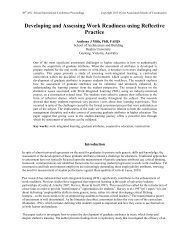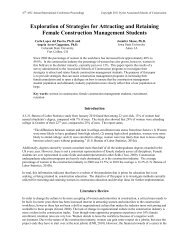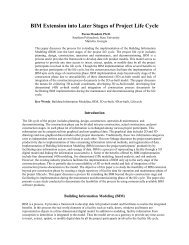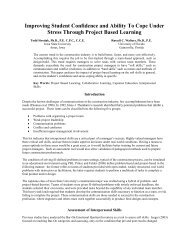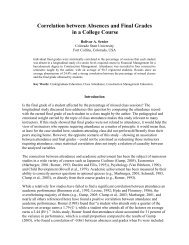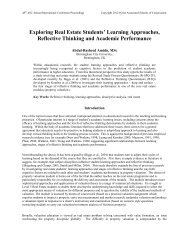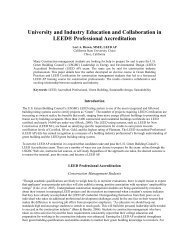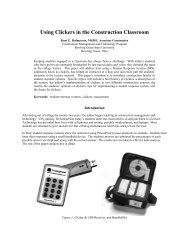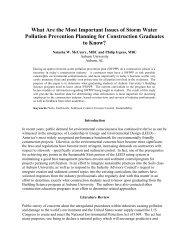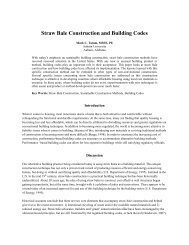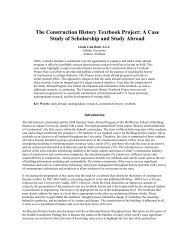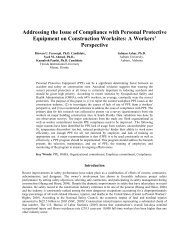Risk Matrix as a Guide to Develop Risk Response Strategies
Risk Matrix as a Guide to Develop Risk Response Strategies
Risk Matrix as a Guide to Develop Risk Response Strategies
You also want an ePaper? Increase the reach of your titles
YUMPU automatically turns print PDFs into web optimized ePapers that Google loves.
<strong>Risk</strong> <strong>Matrix</strong> <strong>as</strong> a <strong>Guide</strong> <strong>to</strong> <strong>Develop</strong> <strong>Risk</strong> <strong>Response</strong><strong>Strategies</strong>Kamalesh Panthi, Ph.D. Candidate andSyed M. Ahmed, Ph.D.Florida International UniversityMiami, FloridaSalman Azhar, Ph.D.Auburn University,Auburn, Alabama<strong>Risk</strong> management plan will be ineffective and incomplete if risk response strategies are notappropriately developed for mitigating risks. <strong>Risk</strong> response development h<strong>as</strong> not been given dueattention it deserves in the risk management process when compared <strong>to</strong> risk identification and<strong>as</strong>sessment of the project risks (Hillson, 1999). <strong>Risk</strong> matrix is a simple yet effective <strong>to</strong>ol <strong>to</strong>develop risk response strategies when risk events/fac<strong>to</strong>rs have been identified and <strong>as</strong>sessed. B<strong>as</strong>edon the probability and the impact, a risk event is mapped in the risk matrix which forms the b<strong>as</strong>isfor formulation of the risk response strategies. An earlier survey carried out in Florida <strong>to</strong> study therisk management practices of construction companies forms the starting point of this research. Thesame study had revealed that over 70% of the companies depended on intuition /judgment/experience <strong>to</strong> manage risks in construction. The study had concluded that the contrac<strong>to</strong>rs inFlorida relied on risk transfer and risk elimination techniques of risk responses more than the riskreduction and risk retention techniques (Ahmed et al., 2001). However, with the use of risk matrixproposed in this paper for developing risk response techniques other appropriate risk responsestrategies are explored.Keywords : <strong>Risk</strong> <strong>Response</strong>, <strong>Risk</strong> <strong>Matrix</strong>, Transfer, Retention, AvoidanceBackground<strong>Risk</strong> h<strong>as</strong> always been major cause of concern in construction industry. <strong>Risk</strong>s inmanufacturing industries are better defined and therefore better managed. However, the risks<strong>as</strong>sociated with construction indus try are seldom crystallized and thus their management is adaunting t<strong>as</strong>k. In an effort <strong>to</strong> study the different types of risks plaguing the Floridaconstruction industry, research w<strong>as</strong> carried out and a report prepared in 2001 by Ahmed et al.<strong>to</strong> develop a Ris k Management Model for Florida Contrac<strong>to</strong>rs. The study compared the riskmanagement practices of Florida contrac<strong>to</strong>rs with the rest of the contrac<strong>to</strong>rs in the U.S. Thestudy concluded that although the sources of risks were not significantly different from thosethat of the other states in the country, there were differences in the ways that those risks werehandled. The study concluded that the contrac<strong>to</strong>rs in Florida relied on risk transfer and riskelimination techniques of risk responses more than the risk reduction and risk retentiontechniques. The study found that the same w<strong>as</strong> not true with the construction industry in someother states where the industry is in a better shape. The contrac<strong>to</strong>rs in these states relied moreon risk reduction and risk retention techniques of risk responses more than the riskelimination and risk t ransfer. B<strong>as</strong>ed on the conclusion and recommendation of that study, thispaper researched on the use of other cost effective risk response techniques in constructionprojects in Florida. Since risk elimination and risk transfer are not always the optimumsolution when other options of risk reduction and risk retention are available; the inclinationof Florida c ontrac<strong>to</strong>rs <strong>to</strong>wards the risk transfer and risk elimination w<strong>as</strong> an interesting <strong>to</strong>picfor research. Is the behavior justified b<strong>as</strong>ed on the sources of risks and the optimal solution <strong>to</strong>it? If not, what are the other risk response strategies that could be used by the c ontrac<strong>to</strong>rs ofFlorida?
Problem statementMost of the construction companies in Florida have iterated the fact that lack of time andresources is the biggest hindrance <strong>to</strong> adopting risk management practices in their companiesand projects (Ahmed, Azhar, and Roldan, 2001). It w<strong>as</strong> found from the same study that forthe majority of the construction companies risk management practices were b<strong>as</strong>ed onintuition/judgment/experience rather than formal risk analysis and management techniques.Although this scenario might have changed over the years for bigger companies with theintroduction of advanced risk management techniques, majority of the smaller and averagesize companies still rely heavily on insurance companies <strong>to</strong> take their risk burden. As a result,the insurance companies thrive well by charging these companies for the risks transferredwhere<strong>as</strong> the construction companies have <strong>to</strong> survive with a little margin on the profit. Otherstrategies <strong>to</strong> counter the risks need <strong>to</strong> be explored in order for the companies <strong>to</strong> maximize ontheir profit.Objective and Scope of ResearchThe objective of the research is <strong>to</strong> formulate appropriate strategies <strong>to</strong> manage each of theidentified risk fac<strong>to</strong>rs b<strong>as</strong>ed on the previous study for construction companies in Florida.Although the premise is that the developed methodology will apply <strong>to</strong> construction projectsin general, the study is targeted <strong>to</strong> the construction companies in Florida.Expected contributionThe study h<strong>as</strong> developed strategies <strong>to</strong> respond <strong>to</strong> the various types of risks already identifiedin the previous study. Use of risk matrix <strong>to</strong> formulate strategies h<strong>as</strong> been exemplified. Whenappropriate responses are developed, contrac<strong>to</strong>rs can use these strategies <strong>to</strong> manage the riskproactively.<strong>Risk</strong> matrix <strong>as</strong> a <strong>to</strong>ol <strong>to</strong> formulate risk response strategiesSeveral criteria are used in judging whether the level of risk is high or low, such <strong>as</strong> theprobability of an undesirable occurrence, the degree of seriousness, and the subsequentimpact if it does occur. One of the widely followed concepts in <strong>as</strong>sessing risk is <strong>to</strong> breakdown the risk in<strong>to</strong> two main criteria (a) the probability, which is the possibility of anundesirable occurrence, such <strong>as</strong> a cost overrun, and (b) the impact, which is the degree ofseriousness and the scale of the impact on the other activities if the undesirable thing occurs.<strong>Risk</strong> response is the process of developing options and determining actions <strong>to</strong> enhanceopportunities and reduce threats <strong>to</strong> the project objectives. This process ensures that theidentified risks are properly addressed. However, when the risk events cannot be solvedthrough the other techniques of risk response such <strong>as</strong> avoidance, transference and mitigation,the only option remaining is the acceptance. This technique indicates that the project teamh<strong>as</strong> decided not <strong>to</strong> change the project plan <strong>to</strong> deal with a risk or is unable <strong>to</strong> identify any othersuitable response strategy. Active acceptance may include developing a contingency plan <strong>to</strong>execute, should a risk occur (PMBOK, 2000). Identification and <strong>as</strong>sessment of risks alonewill not serve the purpose unless meaningful ways <strong>to</strong> mitigate those risks in a structured way
is planned in advance. These effective responses <strong>to</strong> the risks should meet a number of criteriaaccording <strong>to</strong> Hillson .The risk responses should be appropriate, affordable, actionable,achievable, <strong>as</strong>sessed, agreed and allocated (Hillson, 1999).<strong>Risk</strong> <strong>Matrix</strong> is an effective <strong>to</strong>ol <strong>to</strong> illustrate the importance of risk management strategies(Alexander et al., 2006) . <strong>Risk</strong> <strong>Response</strong> Planning Chart used by Piney (2002) is similar <strong>to</strong> therisk matrix concept <strong>to</strong> devise strategies for risk response. Only the values and scales of theaxes may change from project <strong>to</strong> project but the overall shape will remain the same. Thom<strong>as</strong>et al. (2004) used a similar graph of scatter plots <strong>to</strong> prioritize risks and propose suitable riskresponse strategies.MethodologyAs mentioned earlier this research is b<strong>as</strong>ed on the recommendation of the previous researchcarried out in 2001 <strong>to</strong> develop a risk management model for the Florida construction industry.In the previous study numerous risk sources were identified b<strong>as</strong>ed on the checklist from theliterature and later cl<strong>as</strong>sified under risk categories. These risk sources were also <strong>as</strong>sessed interms of probability of their occurrence and impact on the project cost if they occurred. Thisresearch however focused on the implementation of risk management and therefore a simplemethodology is proposed in the following p<strong>as</strong>sage <strong>to</strong> devise risk responses.Having identified and <strong>as</strong>sessed the risk sources, the risk matrix can then guide the projectpersonnel’s choice of risk response strategy. Depending on where the risk source lies on thematrix shown in Figure 1, there are four broad risk response strategies (Alexander et al.,2006).<strong>Risk</strong> <strong>Matrix</strong>MitigateHighRetainAvoidProbabilityRetainTransferLowLowImpactHighFigure 1: <strong>Risk</strong> <strong>Matrix</strong> (Alexander and Marshall, 2006).
<strong>Risk</strong> AvoidanceWhen the chance of occurrence of risk sources and the impact <strong>as</strong>sociated with it are high,then avoidance is the risk response technique that should be followed. Simply speaking, thismeans not choosing <strong>to</strong> do the activity. However, if this means there is a big opportunity lossby avoiding the activity, the effort should be <strong>to</strong>wards clarifying the requirements by obtainingmore information (Hillson, 1999). Changing the scope of work so that risky items in thescope of work are no longer undertaken is also a risk response technique. Sometimes it maynot be e<strong>as</strong>y <strong>to</strong> map the risk sources exactly in one of these quadrants. It may be that some ofthese risk sources lie on the border of these quadrants. In such c<strong>as</strong>es, strategies that are mosteffective should be chosen. In most c<strong>as</strong>es, the effectiveness is me<strong>as</strong>ured in terms of the cost<strong>as</strong>sociated with mitigating these risks.<strong>Risk</strong> TransferWhen the impact is high even though the chance of occurrence of the risk source may berelatively low, risk transfer strategies are applied. The intention is <strong>to</strong> p<strong>as</strong>s such risks <strong>to</strong> a thirdparty which can handle the m better. There are b<strong>as</strong>ically two ways of transferring projectrisks. Insuring the project against any high impact risk sources like hurricane is one way <strong>to</strong>transfer the risk <strong>to</strong> the insurance companies by paying insurance premiums. <strong>Risk</strong> sources canbe transferred through the contracts <strong>to</strong> either owner or other stakeholders of the project.<strong>Risk</strong> MitigationNot all the risk sources can be solved by risk avoidance and transfer. In fact most of the riskscannot be addressed by the above two risk responses. Therefore, for majority of the risks,reduction or mitigation techniques need <strong>to</strong> be applied. Depending on where the risk sourcelies in the risk matrix, mitigation may be done either by reducing the probability of risks orby reducing their impact or both. If the impact of the risk is high, risk reduction may be doneby lessening the extent of the damage. If the risk occurs very often, it is wiser <strong>to</strong> tackle therisk sources at their root by inhibiting their trigger (Hillson, 1999). Whenever the riskprobability and the impacts are high, the response strategy should be <strong>to</strong> reduce both.<strong>Risk</strong> AcceptanceWhen the risk sources fall in the low impact-low probability quadrant of the risk matrix, suchrisks are deemed acceptable. Acceptance can be p<strong>as</strong>sive when the impact is minor for whichno prior plans may be required. Acceptance can be active if the impact if it occurs needs <strong>to</strong> befurther reduced and for such risks contingency plan should be put in place by allocatingsufficient time and resources (Piney, 2002).ProcedureThe following steps are involved in the strategy formulation:1. Identify risk sources2. Assess the probability of risk and its impact for the identified risk for the project.3. Plot risks in the risk matrix similar <strong>to</strong> the one shown in Figure 1.4. Recommend risk response strategies b<strong>as</strong>ed on where the risk lies on the risk matrix.
Steps 1 and 2 are not the focus of this paper. This paper addresses step 3 and 4. However, <strong>to</strong>show the complete process of risk management for construction companies in Florida, steps 1and 2 are taken from the p<strong>as</strong>t research carried out by Ahmed et al. in 2001. Their study w<strong>as</strong>b<strong>as</strong>ed on questionnaire survey from 38 contrac<strong>to</strong>rs from Florida. The study identified risks indifferent categories with the probability and impact elicited from the experienced projectpersonnel through questionnaire survey. The result of the risk survey and the <strong>as</strong>sessment issummarized in Appendix A and is taken from the technical report entitled ‘<strong>Develop</strong>ment of a<strong>Risk</strong> Management Model for Florida Contrac<strong>to</strong>rs’ prepared for Building ConstructionIndustry Advisory Committee (Ahmed et al., 2001). <strong>Risk</strong> sources were then plotted in a riskmatrixchart <strong>as</strong> mentioned in step 3 of the strategy formulation procedure. B<strong>as</strong>ed on where therisk source lied on the risk-matrix, suitable strategies are proposed. These strategies stemfrom the recommendation of the earlier studies applied in similar circumstances (Alexanderet al. 2006; Piney 2002, and Hillson 1999).Results and Discussions<strong>Risk</strong> sources under six different categorie s plotted in separate risk matrix charts are shown inFigure 2 <strong>to</strong> Figure 7.The X-axis of the chart shows the cost impact of the risk in percentage ofthe <strong>to</strong>tal construction cost and the Y-axis of the chart shows the likelihood of occurrence ofeach risk in percentage. The risk matrix c hart not only shows the risk levels but it is dividedin<strong>to</strong> quadrants <strong>to</strong> show the criticality of the risk sources. Different quadrants have differentstrategies for managing risk. This kind of chart helps <strong>to</strong> identify high risk sources andunderstand the relationship between the likelihood and consequence of risks. When the risk isbeyond an unacceptable level these high risks should be mitigated either by reducing thelikelihood of the occurrence of the risk or by reducing the impact of the risk or both.Design <strong>Risk</strong>sThere are no critical design related risks that were identified by the contrac<strong>to</strong>rs in Florida.Incomplete design h<strong>as</strong> a higher probability of occurrence and therefore, the strategy should be<strong>to</strong> reduce the likelihood of incomplete design by thoroughly checking the drawings beforebidding. Part of the project whose design is incomplete should be avoided <strong>as</strong> far <strong>as</strong> possibleand should be included <strong>as</strong> a separate cost item. The cost <strong>as</strong>sociated with defective designshould not be borne by the contrac<strong>to</strong>r and should be transferred <strong>to</strong> the owner. Different sitecondition risk and inadequate specification risk should be transferred <strong>to</strong> the owner. Errors andomissions and defective specification possess no critical risk and strategy should be <strong>to</strong> retainthese risks by the contrac<strong>to</strong>r with constant moni<strong>to</strong>ring.
100Design <strong>Risk</strong>s80RetainAvoidProbability6040Errors & OmissionsDefective SpecificationIncomplete DesignDefective DesignDifferent SiteInadequate Spec. Conditions20RetainTransfer00 10 20 30 40 50Impact on CostFigure 2: <strong>Risk</strong> <strong>Matrix</strong>- Design <strong>Risk</strong>Construction Related <strong>Risk</strong>sDesign changes were <strong>as</strong>sessed <strong>to</strong> be critical in construction related risks. The strategy shouldbe <strong>to</strong> reduce both the likelihood and the impact of this risk. Likelihood can be reduced bystarting the construction only after design h<strong>as</strong> been fully completed. However, whenever thisis not practical it is worthwhile for the contrac<strong>to</strong>r <strong>to</strong> lessen the impact <strong>as</strong>sociated byproposing value engineering solutions <strong>to</strong> the problems and also discussing constructabilityissues with the designer before the design is finalized. When the scope is undefined and thedesign changes are inevitable, the contrac<strong>to</strong>r should not take the cost risks <strong>as</strong>sociated with it.Rather contrac<strong>to</strong>r should opt for cost plus b<strong>as</strong>is of contract for such kind of projects. Laborproductivity is also seen <strong>as</strong> a risk variable whose impact on the project is quite substantial.This kind of risk <strong>as</strong>sociated with low labor productivity should be transferred <strong>to</strong> thesubcontrac<strong>to</strong>r. <strong>Risk</strong> pertaining <strong>to</strong> different site conditions should be transferred <strong>to</strong> the owner.Similarly unrealistic schedule risk should be transferred <strong>to</strong> the third parties, owner <strong>as</strong> well <strong>as</strong>the subcontrac<strong>to</strong>rs. Weather delays are uncontrollable and therefore cannot be avoided. Thebest strategy would be <strong>to</strong> lessen the impact due <strong>to</strong> the inclement weather. This risk should beretained by the contrac<strong>to</strong>r by allocating sufficient contingency in the schedule for suchdelays. Defective work is the responsibility of the contrac<strong>to</strong>r and should be retained by thecontrac<strong>to</strong>r. To bring the risk <strong>to</strong> an acceptable level, the contrac<strong>to</strong>r should emph<strong>as</strong>ize on itsquality control and quality <strong>as</strong>surance. Equipment failure and labor dispute were thought <strong>to</strong> beof lesser risk rating and should be retained by the contrac<strong>to</strong>r.
100Construction <strong>Risk</strong>s80RetainDesign ChangesAvoidProbability6040Weather DelaysUnrealistic ScheduleDifferent SiteConditionsDefective WorkEquipment FailureLabor Productivity20RetainLabor Dispute/StrikeTransfer00 10 20 30 40 50Impact on CostFigure 3 : <strong>Risk</strong> <strong>Matrix</strong>- Construction Related <strong>Risk</strong>sFinancial and Economical <strong>Risk</strong>sFinancial default of the subcontrac<strong>to</strong>r is found <strong>to</strong> be a critical risk in this category. Theimpact <strong>as</strong>sociated with such risks is quite high and therefore the strategy should be <strong>to</strong> reducethe impact by demanding performance bonds from the subcontrac<strong>to</strong>rs. This is one of the risktransfer techniques. Availability of funds from clients is a major risk that h<strong>as</strong> a significantimpact on the contrac<strong>to</strong>r’s profitability even though the likelihood of such risks may not bethat frequent. The strategy is <strong>to</strong> work with clients who have clean p<strong>as</strong>t records regarding thefinancial stability and timely payments. It is best <strong>to</strong> avoid those clients who do not pay ontimely manner and have poor financial status. Cost underestimation is a controllable risk witha high impact. Since the impact cannot be reduced the strategy should be <strong>to</strong> reduce theprobability of cost underestimation by building a strong cost estimating team capable ofaccurately determining the bidding cost. Exchange rate fluctuations and inflation were notperceived <strong>as</strong> very high risks and should be retained by the contrac<strong>to</strong>r. Inflation should beaccounted during the cost estimation and included in the bid. However, if the project durationis long and the inflation rate is very unpredictable, the strategy should be <strong>to</strong> transfer the risk<strong>to</strong> the owner.
Financial & Economical <strong>Risk</strong>s10080RetainAvoidProbability6040Availability of fundsfrom ClientsFinancial default of S/C20InflationRetainExchange RateFluctuationsCost UnderestimationTransfer00 10 20 30 40 50Impact on CostFigure 4: <strong>Risk</strong> <strong>Matrix</strong>- Financial and Economical <strong>Risk</strong>sPolitical and Environmental <strong>Risk</strong>sProjects entangled with bureaucratic problems should be avoided. These projects arefrequently delayed and the contrac<strong>to</strong>r is the ultimate sufferer. Permits and approvals withmajor impact on project duration should be transferred <strong>to</strong> the owner where<strong>as</strong> those havinglesser impact should be accepted by the contrac<strong>to</strong>r. Acquisition approvals should betransferred <strong>to</strong> the client where <strong>as</strong> compliance <strong>to</strong> the pollution and safety rules should be takenby the contrac<strong>to</strong>r. Compliance <strong>to</strong> pollution and safety rules could be transferred <strong>to</strong> thesubcontrac<strong>to</strong>r <strong>as</strong> well. Changes in laws and regulations are uncontrollable risks that should betransferred <strong>to</strong> the client. <strong>Risk</strong> of political pressure and disturbance is not deemed a major riskby Florida contrac<strong>to</strong>rs and is accepted p<strong>as</strong>sively.
100Political & Environmental <strong>Risk</strong>s80RetainAvoidProbability6040Permits & ApprovalPollution and SafetyRulesBureaucratic problemsChanges in laws andregulations20RetainPolitical pressure/disturbancesTransfer00 10 20 30 40 50Impact on CostFigure 5: <strong>Risk</strong> <strong>Matrix</strong>- Political and Environmental <strong>Risk</strong>sPhysical <strong>Risk</strong>sAlmost all the risks falling in physical risk category are high impact risks and the beststrategy is <strong>to</strong> transfer the risk through insurance. Material/e quipment fire and theft, laborinjuries and damage <strong>to</strong> equipment are insured. Impact and likelihood of labor injuries shouldbe reduced by proper safety management by the contrac<strong>to</strong>r. Since there is zero <strong>to</strong>lerance <strong>to</strong>labor injuries the strategy should be <strong>to</strong> reduce the likelihood of the occurrence of the laborinjuries and fatalities <strong>as</strong> much <strong>as</strong> possible and then impact should be transferred <strong>to</strong> theinsurance companies in c<strong>as</strong>es of any mishaps. Damage <strong>to</strong> structure w<strong>as</strong> not perceived <strong>to</strong> be amajor risk and should be retained by the contrac<strong>to</strong>r.
100Physical <strong>Risk</strong>s80RetainAvoidProbability6040Material/Equipment fire& theftLabor Injuries20Damage <strong>to</strong> structureRetainDamage <strong>to</strong> equipmentTransfer00 10 20 30 40 50Impact on CostFigure 6: <strong>Risk</strong> <strong>Matrix</strong>- Physical <strong>Risk</strong>sActs of God <strong>Risk</strong>sWind damage, hurricane/flood damage and fire are all high impact risks falling in thiscategory. Since they are uncontrollable and unpredictable, the strategy should be <strong>to</strong> transferthese risks through insurance. Landslide is not a major risk and should be retained p<strong>as</strong>sivelyby the contrac<strong>to</strong>rs.100Acts of God <strong>Risk</strong>s80RetainAvoidProbability6040Wind DamageHurricane/floodFire20RetainLandslideTransfer00 10 20 30 40 50Impact on CostFigure 7: <strong>Risk</strong> <strong>Matrix</strong>- Acts of God <strong>Risk</strong>s
Conclusion<strong>Risk</strong> response is an important and crucial risk management step without which the whole riskmanagement process is futile. <strong>Risk</strong> matrix serves <strong>as</strong> a good guide <strong>to</strong> develop strategies <strong>to</strong>cope with the various risks identified. It is a simple <strong>to</strong>ol <strong>to</strong> initiate the strategy formulation sothat risks for small and medium sized construction companies are managed well. The riskmatrix can be used effectively when the criticality of the risks are represented well.Following the steps outlined in the methodology it w<strong>as</strong> possible <strong>to</strong> develop appropriatestrategies (avoid, transfer, mitigate or retain) for Florida contrac<strong>to</strong>rs. With the risks allocated<strong>to</strong> the parties which can handle them best, the owner of each risk can further refine theresponses for risks which they own. The guidelines outlined in this paper offer a frameworkfor developing appropriate risk responses from the risk identified during the preconstructionstage so that risk can be managed proactively.ReferencesAlexander, C. & Marshall, M.I. (2006, November 13). The <strong>Risk</strong> <strong>Matrix</strong>: Illustrating theImportance of <strong>Risk</strong> Management <strong>Strategies</strong> [WWW document]. URLhttp://www.joe.org/joe/2006april/tt1.shtml.Ahmed, S., Azhar, S.& Roldan, J. (2001). <strong>Develop</strong>ment of a <strong>Risk</strong> Management Model forFlorida Contrac<strong>to</strong>rs. Technical Report Prepared for Building Construction Industry AdvisoryCommittee (BCIAC), Department of Community Affairs, Florida.Carbone, T.A. & Tippett, D.D. (2004). Project <strong>Risk</strong> Management Using the Project <strong>Risk</strong>FMEA. Engineering Management Journal, 16(4), 28-35.Hillson, D. (1999). <strong>Develop</strong>ing Effective <strong>Risk</strong> <strong>Response</strong>s. Proceedings of the 30 th AnnualProject Management Institute Seminars and Symposium, Philadelphia, USA.PMI (2000). A guide <strong>to</strong> the Project Management Body of Knowledge (PMBOK). ProjectManagement Institute, New<strong>to</strong>n Square, Pennsylvania, USAPine y, C. (2002). <strong>Risk</strong> <strong>Response</strong> Planning: Selecting the Right Strategy. Fifth EuropeanProject Management Conference, PMI Europe.
<strong>Risk</strong>Appendix AThe <strong>as</strong>sessed critical risks cl<strong>as</strong>sified according <strong>to</strong> their categoryChance of Occurrence Potential Loss (% of project <strong>to</strong>tal cost)Design % %Incomplete Design 60 20Defective Design 52 25.3Defective Specification 42.6 20Errors and Omissions 48 20.7Inadequate Specifications 45.4 22.7Different Site Conditions 46.2 31.2Construction RelatedWeather Delays 60 18.1Labor dispute and Strike 20 16.2Labor Productivity 54.6 26.4Unrealistic Schedule 54.6 24.4Design Changes 72 24.4Equipment Failure 32.8 15Defective Work 45.8 19.3Different Site Conditions 56 24Financial and EconomicsInflation 28.6 12.3Availability of Funds from Clients 38.6 22.9Financial Default of Prime / S/C 40 40Exchange Rate Fluctuations 25.4 13.1Cost Underestimation 32 28Political and EnvironmentalChanges in Laws and Regulations 42.6 25Permits & Approval 55.2 18.7Pollution and Safety Rules 40 24.3Political Pressure/Disturbances 25.4 13.6Bureaucratic Problems 57.6 21.4PhysicalDamage <strong>to</strong> Structure 25.8 16.2Damage <strong>to</strong> Equipment 24 18.5Labor Injuries 32 29.3Material & Equip. Fire and Theft 41.2 22Acts of GodHurricane/Flood 33 25.7Landslide 24.2 16.7Fire 29.2 31.5Wind Damage 41.6 29.2



